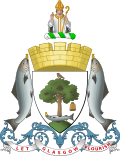Greater Glasgow
| |
|---|---|
 Satellite image showing the Greater Glasgow Area in the 1990s | |
| Area | 265 km2 (102 sq mi) [1] |
| Population | 1,028,220 (2020) [2] |
| Language | English, Scots, Gaelic [3] |
| OS grid reference | NS590655 |
| • Edinburgh | 42 mi (68 km) |
| • London | 403 mi (649 km) |
| Country | Scotland |
| Sovereign state | United Kingdom |
| Post town | GLASGOW |
| Postcode district | G1–G84 |
| Post town | PAISLEY |
| Postcode district | PA1–PA19 |
| Post town | MOTHERWELL |
| Postcode district | ML1–ML8 |
| Dialling code | 0141, 01236, 01355, 01360, 01389, 01505, 01698, 01475 |
Greater Glasgow is an urban settlement in Scotland consisting of all localities which are physically attached to the city of Glasgow, forming with it a single contiguous urban area (or conurbation). It does not relate to municipal government boundaries, and its territorial extent is defined by National Records of Scotland, which determines settlements in Scotland for census and statistical purposes. Greater Glasgow had a population of 1,199,629 at the time of the 2001 UK Census [4] making it the largest urban area in Scotland and the fifth-largest in the United Kingdom. [5] However, the population estimate for the Greater Glasgow 'settlement' (a chain of continuously populated postcodes) in mid-2016 was 985,290 [6] —the reduced figure explained by the removal of the Motherwell & Wishaw (124,790), Coatbridge & Airdrie (91,020), and Hamilton (83,730) settlement areas east of the city due to small gaps between the populated postcodes. The 'new towns' of Cumbernauld (which had a 2016 settlement population of 50,920) and East Kilbride (75,120) were never included in these figures despite their close ties to Glasgow due to having a clear geographical separation from the city. In the 2020 figures (with almost the same boundaries as 2016, the main difference being the re-addition of Barrhead), the Greater Glasgow population had risen to just over 1 million. [2]
Contents
A more extensive Greater Glasgow concept covers a much larger area and may include Ayrshire down to Ayr as well as the whole of Lanarkshire down to Lanark, Dunbartonshire, Renfrewshire, and Inverclyde. At present, the Glasgow City Region consists of the Glasgow City Council, North Lanarkshire, South Lanarkshire, West Dunbartonshire, East Dunbartonshire, Renfrewshire, East Renfrewshire, and Inverclyde Local Authorities, with a combined population of over 1.7 million. This city-region is described as a metropolitan area by its own strategic planning authority and is similar to the Glasgow metropolitan area identified by the European Union.
The City of Glasgow grew substantially in population during the late nineteenth and early twentieth centuries, becoming in 1912 the eighth city in Europe to reach the one million mark after Rome, London, Paris, Berlin, Vienna, St. Petersburg, and Moscow. The official population stayed over a million for fifty years. [7] Since the 1960s, successive boundary changes and large-scale relocation to suburban districts and new towns have reduced the population of the City of Glasgow council area to 593,245 at the time of the 2011 UK Census.

